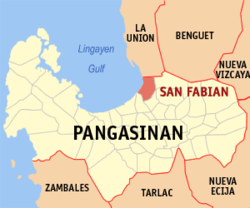San Fabian | |
|---|---|
| Municipality of San Fabian | |
 Poblacion | |
| Anthem: Baley Kon San Fabian | |
 Map of Pangasinan with San Fabian highlighted | |
Location within the Philippines | |
| Coordinates: 16°09′N 120°27′E / 16.15°N 120.45°E | |
| Country | Philippines |
| Region | Ilocos Region |
| Province | Pangasinan |
| District | 4th district |
| Founded | March 21, 1717 |
| Named for | Pope Fabian |
| Barangays | 34 (see Barangays) |
| Government | |
| • Type | Sangguniang Bayan |
| • Mayor | Marlyn E. Agbayani |
| • Vice Mayor | Constante B. Agbayani |
| • Representative | Christopher P. de Venecia |
| • Municipal Council | Members |
| • Electorate | 57,896 voters (2022) |
| Area | |
| • Total | 81.28 km2 (31.38 sq mi) |
| Elevation | 7.0 m (23.0 ft) |
| Highest elevation | 110 m (360 ft) |
| Lowest elevation | −3 m (−10 ft) |
| Population (2020 census)[3] | |
| • Total | 87,428 |
| • Density | 1,100/km2 (2,800/sq mi) |
| • Households | 22,669 |
| Economy | |
| • Income class | 1st municipal income class |
| • Poverty incidence | 17.21 |
| • Revenue | ₱ 231.2 million (2020) |
| • Assets | ₱ 206.6 million (2020) |
| • Expenditure | ₱ 212.3 million (2020) |
| • Liabilities | ₱ 26.59 million (2020) |
| Service provider | |
| • Electricity | Dagupan Electric Corporation (DECORP) |
| Time zone | UTC+8 (PST) |
| ZIP code | 2433 |
| PSGC | |
| IDD : area code | +63 (0)75 |
| Native languages | Pangasinan Ilocano Tagalog |
| Website | www |
San Fabian, officially the Municipality of San Fabian (Pangasinan: Baley na San Fabian; Ilocano: Ili ti San Fabian; Tagalog: Bayan ng San Fabian), is a 1st class municipality in the province of Pangasinan, Philippines. According to the 2020 census, it has a population of 87,428 people.[3]
- ^ Municipality of San Fabian | (DILG)
- ^ "2015 Census of Population, Report No. 3 – Population, Land Area, and Population Density" (PDF). Philippine Statistics Authority. Quezon City, Philippines. August 2016. ISSN 0117-1453. Archived (PDF) from the original on May 25, 2021. Retrieved July 16, 2021.
- ^ a b Census of Population (2020). "Region I (Ilocos Region)". Total Population by Province, City, Municipality and Barangay. Philippine Statistics Authority. Retrieved July 8, 2021.
- ^ "PSA Releases the 2021 City and Municipal Level Poverty Estimates". Philippine Statistics Authority. April 2, 2024. Retrieved April 28, 2024.



